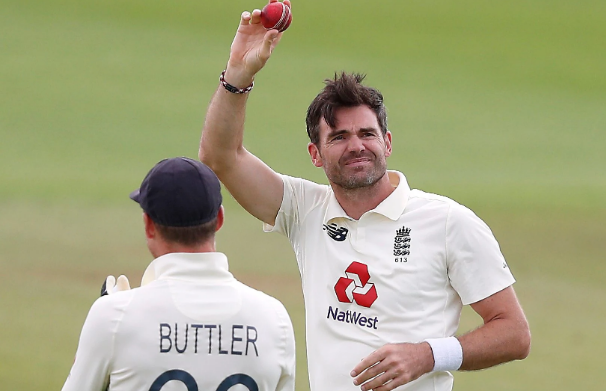The Burnley Express
0On 15th December 2002, England played Australia in the second match of the VB Series at the Melbourne Cricket Ground. This was an England squad that had lost the first three tests and with it, the Ashes, before this triangular series with Sri Lanka had even begun. Australia had also won the first ODI versus England in Sydney two days before, by 7 wickets with 5 overs to spare. Coach Duncan Fletcher and captain Nasser Hussain made one change to their bowling attack with Andy Caddick being replaced by a young debutant who had only made his first class debut for Lancashire earlier that year. England suffered yet another defeat, going down by 89 runs. The introduction of Jimmy Anderson saw him return figures of 6 overs, 1 wicket for 46 and an economy rate of 7.66. His wicket? That of Adam Gilchrist, who he bowled for 124 in the 38th over.
Anderson went on to play all but one of the remaining ODI’s in the VB Series and secured his place in the England squad for the 2003 World Cup, which started a few weeks later. England’s first match in Pool A was scheduled to be against Zimbabwe, in Harare, but England didn’t travel due to safety concerns. England forfeited the match, finished fourth in the pool, two points behind Zimbabwe, who took the last place in the Super Sixes. Anderson had a reasonable World Cup, with the highlight being figures of 4/29 against Pakistan at Newlands, a man of the match performance.
Zimbabwe and South Africa toured England in the English summer that followed and Anderson made his test debut in the first test against Zimbabwe at Lords, taking 5/73 in the first innings. The South African challenge was much harder however and in the five match series (drawn 2-2) the highlight was 5/102 in the third test at Trent Bridge. He finished his first calendar year in test cricket with 26 wickets in 8 tests and an average of 34.85. Michael Vaughan, the new England captain said ‘We have to remember this is his first loss of form. He has never gone through a loss of form for Lancashire. It is a lot harder for him but he will be a stronger guy for it.’ His technique was also receiving attention, with Bob Willis suggesting that his action (where he had his head down, not looking where he was bowling) would only be able to last for five years unless he changed. Although he worked with England bowling coach Troy Cooley, changing the action resulted in a decrease in pace, so they canned that with Anderson remarking ‘I’ve tried bowling with my head up all the way and it just floats out. My eyes are shut when I deliver the ball anyway.’
Unfortunately, 2004 saw the form slump continue and he played just 3 tests, taking 7 wickets. With a home Ashes series the following year and England in good test form without him, Anderson was left to ply his trade back at Lancashire. With Simon Jones injured for the final Ashes test in 2005, and Anderson recalled to the squad, his missed out on the final XI to Paul Collingwood.
In and out of the team in the next couple of years, 2008 was the year that Anderson properly re-emerged, playing 11 tests and taking 46 wickets at 29.85. His stint with Auckland, when his career was a a low ebb could be seen as the turning point.
New Zealand were the home and away opponent in 5 of those tests, with 5/73 at the Basin Reserve and 7/43 at Trent Bridge the standout performances. He took his 100th test wicket, that of Jacques Kallis, at the Oval.
Since then, Anderson has consistently delivered year on year. Between 2008 and 2018, his lowest annual test wicket haul was 35 in 2011, when he played 7 tests. He has formed an incredible partnership with Stuart Broad (who himself has 514 test wickets). He has played under eight different England captains in 17 years and 156 tests. Overnight he claimed his 600th test wicket when he had Pakistan’s Azhar Ali caught at first slip on the last day of the third test in Southampton.
Now 38, Anderson has shown incredible longevity. He has had relatively few injuries, especially when you consider his role within the team. His average stands at 26.80 with a strike rate of 56.24. Only Muttiah Muralitharan, Shane Warne and Anil Kumble sit above him in terms of test wickets. He has taken a total of 887 international wickets across all three formats, which is sixth on the all-time list. 89 of his 156 tests have been at home and they have produced 384 wickets at an average of 23.84. The assumption that his home performances far outweigh those away from home is understandable, but it’s not as skewed as many would think.
Glenn McGrath, now second in the all time list for wickets by a fast bowler (with 563) paid tribute by saying ‘I didn’t have the skill level that Jimmy has. When he’s swinging that ball, both ways, in control, there’s no one better.’
When people consider the all time greats of the game, Jimmy Anderson won’t appear on as many fast bowler lists as the likes of Hadlee, McGrath, Lillee, Akram and others, and that’s a shame, because when you look at his career to date, this is a player who has made the most of his ability, performed consistently for many years, broken records and despite his age, looks like he could go on for a few years yet. Who would bet against 650 or 700 test wickets? Maybe those who have written him off before, but I won’t be one of them.
Follow Aiden on Twitter

